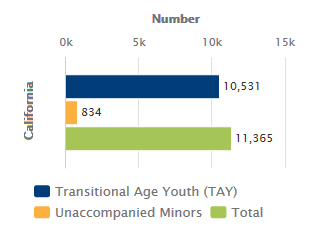California streets 'home' to 11,365 youth, 2015 count reveals
More than 10,000 transitional-age youth (ages 18-24) and nearly 1,000 unaccompanied minors (ages 0-17) were found to be living in places not meant for human habitation, such as cars, parks, abandoned buildings, transit stations, and on streets, during the 2015 national "Point-in-Time" homeless count in January.
For the past ten years, the US Department of Housing and Urban Development has required communities receiving federal funding for homeless prevention programs to conduct an annual count of homeless individuals within one 24-hour time period. For more information about the 2015 California count, read the California Homeless Youth Project's full report, We Count, California!: Lessons Learned from Efforts to Improve Youth Inclusion in California’s 2015 Point-in-Time Counts (PDF).
Although critical to enhancing our understanding of the severity of this issue, the count of unsheltered homeless children and youth likely does not reflect the true extent of youth homelessness in California communities. For example, nearly 300,000 public school students in California, 5% of all public school students, were identified as homeless at some point during the 2013-2014 school year, per the McKinney-Vento Act education definition.
Homelessness contributes to a range of mental and physical health risks as well as academic challenges for children and youth. California has the second highest rate of homeless youth in the country and ranks 48th out of 50 states in addressing the issue. For example, two-thirds of California counties lack shelters for homeless youth.
Policies that can help alleviate youth homelessness include identifying families at risk of homelessness, offering housing support services to help families remain in their homes, explicitly addressing the needs of homeless students in Local Control and Accountability Plans, providing employment and job training for parents and youth, and connecting youth to trustworthy adults and/or support organizations.
Related Data:
Homelessness (summary)
Helpful Links
We Count, California!: Lessons Learned from Efforts to Improve Youth Inclusion in California's 2015 Point-in-Time Counts (PDF), 2015, Lin, J., Petry, L., Hyatt, S., & Auerswald, C.
California Coalition for Youth (CCY)
California Youth Crisis Line (CYCL)
California Homeless Youth Project, California State Library, California Research Bureau, State of California
National Association for the Education of Homeless Children and Youth (NAEHCY)
National Center for Homeless Education (NCHE)
United States Interagency Council on Homelessness
Portrait of Promise: The California Statewide Plan to Promote Health and Mental Health Equity, 2015, California Department of Public Health Office of Health Equity
Child Trends Databank: Homeless Children and Youth
Kidsdata Tip
Need help with kidsdata.org? Watch our tutorials, send us an email or give us a call at (650) 736-0676. We're here to help!
|
Unsheltered Homeless Youth (Point-in-Time Count), by Age Group
Year: 2015

|

